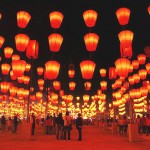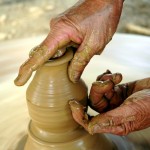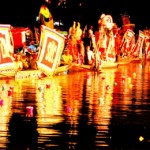This festival falls on the 12th day of the second month of the lunar calendar, and is celebrated in Lady Thu Bon?s Palace in Duy Tan commune, Duy Xuyen district. It is a traditional festival of the ancient Cham Pa people that was inherited and is still kept nowadays.
Lady Thu Bon, also known as Lady Bo Bo, is the woman who had a great contribution to agriculture and fishery in alluvial land. During the festival, the atmosphere is animated and people are excited. Apart from the offerings, the festival includes traditional games and processions such as regatta, vehicle and water processions, dances and festival songs. Boat races are still some of the most interesting activities of the Thu Bon Goddess Festival, though now the competing teams come solely from Quang Nam. Before the race, all contestants attend a worshiping ceremony, offering incense at Thu Bon Temple. Apart from the ceremonies and their legends, festival-goers can also enjoy art performances, fashion shows, a national beach volleyball tournament, photo exhibitions on Quang Nam, and seminars on culture preservation.
During these days, Thu Bon river is sometimes waved by the acclamation and encouragement along two riversides but sometimes is engraved and fond in the memory of the past. Now, the Lady Thu Bon festival is being revived by the Duy Xuyen authorities, with the use of many ancient games from the Central region. Coming to the festival, tourists have a chance to visit My Son Temple and Tower Zone – a famous World cultural heritage.
The elderly villagers usually tell their offspring about the goddess’ supernatural powers. One legend has it that a man came to Thu Bon Temple to beg Thu Bon to help his wife during her difficult delivery. Responding to the man’s prayers, Thu Bon incarnated into the man’s body and quickly rushed across a large field with a lighting candle. When she arrived in the man’s home, she touched the wife’s belly, and the woman gave birth immediately.
Another tale says Thu Bon Village had an extremely bad harvest in the Year of the Dragon 1928, so the villagers gathered to decide how to organize that year’s festival in a simple way. While they were discussing, a cow came and lay down in front of the temple. But it wasn’t just any cow – the villagers could see it had a string of 3,000 coins hunging from its horns. They immediately understood the goddess was giving them money to organise the festival, so they took the coins and released the cow into the forest. A villager who followed the cow later said he saw it going to the My Son, a complex of towers built by the Champa people, where it turned into stone.
Soure: hoian-tourism.com
Post Views:
2,274







